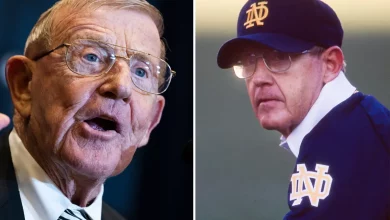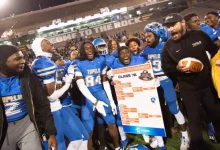Mike Tomlin’s leadership fosters a close bond with players, creating a unique “bromance” dynamic within the Steelers’ team.

Mike Tomlin, the head coach of the Pittsburgh Steelers, is widely regarded not only for his strategic brilliance on the football field but also for his exceptional leadership qualities that have made him one of the most respected figures in the NFL. Beyond the Xs and Os, one of the most notable aspects of Tomlin’s tenure has been the culture he has cultivated within the Steelers’ locker room. A unique bond exists between Tomlin and his players, often referred to as a “bromance.” This term may sound lighthearted, but it signifies something much deeper—an emotional connection that goes beyond typical coach-player relationships and speaks to the trust, respect, and mutual admiration that define Tomlin’s leadership.
The Early Years and Tomlin’s Leadership Style
Mike Tomlin took over as the Steelers’ head coach in 2007, succeeding Bill Cowher, who had built a legacy of success in Pittsburgh. Tomlin was only 34 years old at the time, making him the youngest head coach in NFL history to win a Super Bowl when the Steelers triumphed in Super Bowl XLIII during the 2008 season. His arrival marked a new era for the team, and though Tomlin’s background was primarily defensive, his leadership style was quickly characterized by his calm demeanor, approachable nature, and a commitment to fostering a culture of accountability and mutual respect.
From the very beginning, Tomlin’s approach was distinct. Unlike some coaches who thrive on maintaining a strict, authoritarian presence, Tomlin leaned into a more inclusive leadership style. He communicated openly with his players and made a point of connecting with them on a personal level. His ability to create an environment where players felt heard and valued became a cornerstone of his success as a leader.
This style was especially important in a locker room filled with diverse personalities, including outspoken veterans, young stars, and rising talents. Tomlin’s leadership transcended mere football; it was about building relationships and creating a team-first mentality. This dynamic began to foster the special kind of “bromance” between Tomlin and his players—a closeness built on trust, understanding, and shared goals.
Building Trust Through Communication
One of the most important aspects of Tomlin’s leadership is his ability to communicate with players. He has consistently shown that he values open dialogue and transparency, which allows for genuine connections. Tomlin’s approach to communication is not top-down; rather, he listens to his players and works with them to solve problems.
For instance, Tomlin is known for his “open-door” policy, where players feel comfortable approaching him with concerns, questions, or personal issues. This accessibility builds trust between Tomlin and his players, allowing for deeper emotional connections to form. When players know their coach is genuinely invested in their well-being—both on and off the field—they are more likely to respect him not just as a coach but as a mentor and a friend.
Many Steelers players have spoken about the personal relationship they have with Tomlin. For example, former Steelers wide receiver Antonio Brown once described Tomlin as a “father figure” and someone who helped him grow both professionally and personally. Brown’s comments are indicative of how Tomlin manages to balance his role as a leader with a genuine concern for his players as people.
Tomlin’s communication is not limited to one-on-one conversations. His ability to speak to the team as a whole, motivating them and reinforcing the team’s core values, has also been a key factor in building the strong bond he shares with his players. His famous speeches and post-game locker room addresses often resonate with the team, giving players a sense of purpose and a feeling of unity. It’s clear that Tomlin’s leadership has always been about more than just football—it’s about building relationships that lead to success.
A Culture of Accountability
While Mike Tomlin’s leadership is marked by his warm and personable approach, it is also defined by his unyielding commitment to accountability. This is perhaps one of the most critical aspects of the “bromance” dynamic within the Steelers’ team. For Tomlin, accountability isn’t just about holding players responsible for their performance on the field—it’s about holding each individual responsible for their actions and decisions in all aspects of their lives.
This culture of accountability creates a sense of camaraderie among players. They know that they are all in it together and that they are held to high standards by their coach, but also by each other. Tomlin’s leadership encourages players to push one another to be better and to hold each other accountable when needed. This creates a bond that goes beyond the traditional coach-player relationship. It’s a brotherhood—a team that can trust each other to not only perform at their best but to help each other grow as individuals.
Tomlin’s demand for accountability has been a defining characteristic of the Steelers’ success under his leadership. It’s one thing to have talented players, but it’s another to have a team that is disciplined and willing to work hard together to achieve a common goal. The Steelers’ “Steel Curtain” defense and hard-nosed playing style have always reflected Tomlin’s emphasis on accountability and teamwork. Even when the Steelers experience setbacks, they know that Tomlin expects them to remain resilient and disciplined in their approach.
The Impact of “Bromance” on the Steelers’ Performance
The deep emotional connection between Mike Tomlin and his players has tangible benefits on the field. Football is a sport where success depends on trust and communication, and Tomlin has cultivated both in his team. Players who feel valued and supported by their coach are more likely to go the extra mile for the team, whether that means making a key tackle in a critical moment or showing up for extra practice.
Tomlin’s leadership style has led to numerous successful seasons for the Steelers. Under his guidance, the team has reached the playoffs multiple times and has maintained a level of competitiveness that is the envy of many franchises. The Steelers’ success can be partially attributed to the strong bond between Tomlin and his players, which fosters a collective drive for excellence.
Perhaps the most profound example of this relationship came during the 2008 Super Bowl run. Despite a rocky start to the season and several key injuries, Tomlin’s leadership and the strength of the bonds he had cultivated with his players kept the Steelers focused. The result was a dominant playoff run that culminated in a Super Bowl victory. The team’s perseverance in the face of adversity was a direct reflection of Tomlin’s ability to connect with his players on a personal level and inspire them to play for one another.
The Role of Tomlin’s Leadership in Player Development
The “bromance” between Mike Tomlin and his players is not just about trust and accountability—it’s also about player development. Tomlin has been instrumental in helping many players reach their full potential, both on and off the field. He has been able to bring out the best in players who may have struggled with consistency, work ethic, or focus.
Players such as Ben Roethlisberger, Le’Veon Bell, and James Harrison have all credited Tomlin with being a significant influence on their development and success. Tomlin’s ability to push his players to new heights while maintaining a supportive relationship with them is a testament to his unique leadership style. He does not simply manage his team—he helps shape them into better individuals, both as athletes and as people.
A key part of this development is Tomlin’s approach to mentorship. He is known for taking young players under his wing and providing them with the guidance and support they need to succeed. Whether it’s teaching them how to deal with the pressures of being a professional athlete or helping them navigate the challenges of life off the field, Tomlin’s mentorship creates an environment where players feel empowered to grow.
The Legacy of Mike Tomlin’s Leadership
Mike Tomlin’s leadership style, marked by a deep emotional connection with his players, has left an indelible mark on the Pittsburgh Steelers organization. The unique “bromance” dynamic that exists between Tomlin and his players is a testament to his ability to foster relationships based on trust, respect, and shared goals. This bond has not only contributed to the team’s success on the field but has also helped create a culture of accountability, mutual support, and growth.
As Tomlin continues his career as the Steelers’ head coach, it’s clear that his leadership will remain a key factor in the team’s ongoing success. The relationships he has built with his players are more than just friendships—they are part of the foundation that drives the Steelers’ commitment to excellence. In the world of professional sports, where high-pressure situations and egos often get in the way, Mike Tomlin’s ability to create a team-first mentality and foster deep connections with his players is nothing short of remarkable. The “bromance” between Tomlin and his players is a powerful force that has propelled the Steelers to sustained success and will likely continue to be a driving force for years to come.









